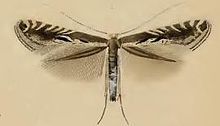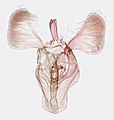| Parornix anglicella | |
|---|---|

| |

| |
| Scientific classification | |
| Domain: | Eukaryota |
| Kingdom: | Animalia |
| Phylum: | Arthropoda |
| Class: | Insecta |
| Order: | Lepidoptera |
| Family: | Gracillariidae |
| Genus: | Parornix |
| Species: | P. anglicella |
| Binomial name | |
| Parornix anglicella (Stainton, 1850) | |
| Synonyms | |
| |
Parornix anglicella is a moth of the family Gracillariidae found in Asia and Europe. It was described in 1850, by the English entomologist Henry Tibbats Stainton, from a specimen from Lewisham, Kent.
Description
For a key to the terms used, see Glossary of entomology terms.The wingspan is 9–11 mm. The head is ochreous-whitish mixed with fuscous. Palpi white, apex of second joint and median band of terminal dark fuscous. Forewings are dark fuscous, irrorated with whitish; numerous costal strigulae, a spot in middle of disc and another posteriorly, and suffused dorsal strigidae interrupted by two blackish spots white; a black apical dot; cilia with three entire dark fuscous lines. Hindwings are grey. The larva is pale greenish-grey; dorsal line darker; spots pale; head pale greenish-brown; segment 2 with four black spots.
Biology
Adults are on the wing in two generations in April and May and again in August.
- Ovum
Eggs are laid on the underside of the leaves of hawthorns (Crataegus species), but have also been recorded on medlar (Mespilus germanica), rowan (Sorbus aucuparia), wild service tree (Sorbus torminalis) and strawberries (Fragaria species).
- Larvae
Feeding starts in a gallery in the epidermis, which leads to a leaf margin and develops into a blotch in the second instar. In the next phase the larva eats through to the upper epidermis, puckers the leaf and the epidermis turns brown and the frass is at one end of the mine. It is distinguished from a Phyllonorycter oxyacanthae mine, by the smaller size and the lower epidermis stays green. After leaving the mine two or more cones are made by folding the leaves downwards in the manner of a Caloptilia rather than other Parornix. Occupied mines can be found from July to September.
- Pupa
The pupa is pale-yellow-brown in a whitish cocoon, sometimes spun under a narrowly folded edge of a leaf, or in leaf-litter or an old bird's nest. Pupation takes place in July-August and September to late-April.
Gallery
-
A hawthorn leaf with a mine of a young larva and two cones formed by adult larvae
-

-

-

Distribution
It is widespread in: Europe including Albania, Austria, Belarus, Belgium, Bosnia and Herzegovina, Britain, Bulgaria, Croatia, Corsica, Czech Republic, Danish mainland, Estonia, Finland, French mainland, Germany, Hungary, Ireland, Italian mainland, Latvia, Lithuania, Luxembourg, Montenegro, North Macedonia, Norwegian mainland, Poland, Portuguese mainland, Romania, central and northern Russia, Sardinia, Serbia, Sicily, Slovakia, Slovenia, Sweden, Switzerland, Netherlands, Ukraine. Outside Europe it is recorded from the Near East and Nearctic realm.
Taxonomy
The genus Paronix comes from para, meaning alongside and ornix named after the genus Ornix Treitschke, 1833, which refers to ornis, a bird. The genus Ornix originally included a wide range of feathery-winged microlepidoptera in the Coleophoridae and the Gracillariidae. Ornix was an early synonym of the genus Coleophora as a number of moths were name after birds. The feathery-winged moths were later restricted to Paronix. The specific name anglicella refers to Anglicus i.e. English; the type locality is from England.
References
- Meyrick, E., 1895 A Handbook of British Lepidoptera MacMillan, London pdf
 This article incorporates text from this source, which is in the public domain. Keys and description
This article incorporates text from this source, which is in the public domain. Keys and description
- Kuznetsov V.I., 1990 Gracillariidae ; in G.S. Medvedev (ed.): Keys to the insects of the europaean part of the USSR, Vol.IV: Lepidoptera, part 2 (english translation), Oxonian Press Pvt.Ltd., New Dehli, 1987
- Heath, J. & Emmet, A. M. (Hrsg.) (1985): The Moths and Butterflies of Great Britain and Ireland. Volume 2: Cossidae – Heliodinidae. Harley Books, Colchester, Essex.
- Kimber, Ian. "15.028 BF303 Parornix anglicella (Stainton, 1850)". UKmoths. Retrieved 18 January 2024.
- ^ Emmet, A M; Watkinson, I A; Wilson, M R (1985). Gracillaridae. In Moths and Butterflies of Great Britain and Ireland. Volume 2. Colchester: Harley Books. p. 280–2. ISBN 0-946589-19-4.
- "15.028 Parornix anglicella (Stainton, 1850)". British Leafminers. Retrieved 22 January 2024.
- Emmet, A Maitland (1991). The Scientific Names of the British Lepidoptera. Their history and meaning. Colchester: Harley Books. pp. 63, 74 &75. ISBN 0 946589 35 6.
External links
| Taxon identifiers | |
|---|---|
| Parornix anglicella |
|